Chapter 13 Mind Map
by Taiylor Peratt

1. 13.4-What Does the Inflation Rate Reveal About an Economy’s Health?
1.1. Economists at the BLS track changes in the cost of living using what is known as the consumer price index.
1.2. The CPI market basket is based on surveys of thousands of households about their spending habits. BLS data collectors visit some 25,000 retail stores and record the prices of these items.
1.3. The real cost of living is the nominal cost of basic goods and services, adjusted for inflation.
1.4. The BLS has taken steps to reduce such biases through increasingly sophisticated methods of gathering data.
2. 13.5-How Does the Business Cycle Relate to Economic Health?
2.1. A period of economic growth is known as an expansion. During this phase of the business cycle, economic activity generally increases from month to month.
2.2. Leading indicators. Measures that consistently rise or fall several months before an expansion or a contraction begins are called leading economic indicators.
2.3. Coincident indicators are most helpful in tracking expansions and contractions as they happen.
2.4. Economists use lagging indicators to confirm that one phase of the business cycle has ended and another has begun.
3. 10 Key terms
3.1. Gross domestic product: the market value of all final goods and services produced within a country during a given period of time
3.2. Market value: the price buyers are willing to pay for a good or service in a competitive market
3.3. Final good: any new good that is ready for consumer use; final goods are included in the calculation of GDP
3.4. Intermediate good: a good used in the production of a final good; intermediate goods are not included in the calculation of GDP
3.5. Current dollars: the value of a dollar in the year it is spent; a measure of the dollar’s value that reflects current purchasing power, without taking inflation into account
3.6. Per capita GDP: a nation’s real GDP divided by its population; a measure of average economic output per person
3.7. Literacy rate: the percentage of people in a country who can read and write
3.8. Frictional unemployment: a type of unemployment that results when workers are seeking their first job or have left one job and are seeking another
3.9. Cost-of-living index: a measure of change in the overall cost of goods and services; another term for the consumer price index
3.10. Creeping inflation: a gradual, steady rise in the price of goods and services over time
4. 13.2-How Do Economists Measure the Size of an Economy?
4.1. The main measure of the size of a nation's economy is its gross domestic product. GDP is an economic indicator that measures a country's total economic output.
4.2. Economists typically calculate GDP by measuring expenditures on goods and services produced in a country. They divide the economy into four sectors: households, businesses, government, and foreign trade.
4.3. As a country's per capita GDP increases, so too do other indicators of well-being, such as: Literacy & Education, Health & life expectancy, Standard of living.
4.4. The job of measuring U.S. GDP belongs to the Department of Commerce's Bureau of Economic Analysis.
5. 13.3-What Does the Unemployment Rate Tell Us About an Economy’s Health?
5.1. By examining a small but representative sample of the population, the BLS can gauge how many people in the entire population are unemployed.
5.2. To be counted as unemployed, individuals must have actively looked for work in the four weeks preceding the survey week. They had to have inquired about jobs, sent out resumes, filled out job applications, or otherwise sought work.
5.3. Four types of unemployment: Frictional unemployment, Structural unemployment, Seasonal unemployment, Cyclical unemployment.
5.4. The smaller the number of people who are working, the fewer goods and services the economy can generate.


